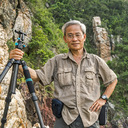2 Likes
Photographing creatures on a coral reef - anywhere in the world - is a problem. The reef fish and any other mobile creatures are scared to death of humans in the water. This may, in part, be due to the fact that we are big - bigger even than most reef sharks - and big creatures are usually hunting for something to eat. And in New Caledonia almost every male that shows up on the reef is armed, deadly, and dangerous. The only places a photographer can get a semi-natural photo is within marine reserves where the fish have been unharmed for many fish generations. And even there the smaller ones retreat into the coral when a human approaches. This is even more of a problem with sphere images because you need to be right on top of the smaller fish to get a decent image of them with the fish-eye lens.
Yesterday I tried out my new work-around for this problem. I automated my camera using a tiny little infrared intervalometer - a gentLED-AUTO 051 - made by Gentles Ltd. and a home-built camera rotator that turned the camera 360 degrees once every minute. This was my first test and it was in shallow water on a reef at Ilot Mato. Being practically New Years eve there were a lot of yachts in the anchorage and I noticed that most of the holiday makers were heading off to the reef with mask, fins, snorkles.... and spear guns. The fish were especially shy and I could see them finning madly away as soon as I entered the water. It is true I wanted to hunt them, but only to shoot their image with my camera. But they were not taking any chances.
I set the camera up next to a thicket of Acropora coral. The tiny electric-blue damsel fish instantly retreated into the protective arms of the coral (as usual) and watched me set everything up. Then Frederique and I swam off and the camera ever so slowly turned around taking photos every 3 seconds. We swam downstream so our metabolites would not frighten the fish and went hunting for photos along the edge of the reef. Freddy and I had a contest going - which one of us could take the best photo that showed a story. A photo of behavior of the coral reef creatures that - in one shot - would make the viewer understand the point of the story. Even better if it made the viewer smile.
After about 20 minutes I figured that the creatures around the camera must have gone back to "normal" behavior. Unless of course the presence of the very weird camera apparatus kept them in retreat. So we headed back to the scene. As happy coincidence would have it we came upon a cuttlefish hiding under a coral head, peeping out at us. Cuttlefish are very smart little creatures and can change their color and color pattern to vanish into their surroundings and also to communicate with each other and other reef creatures. This one was a dark red with a mottled pattern that matched the surrounding coral hideout perfectly.
I dove down, my little point-and-shoot ready, and took some photos. Freddy did too. The cuttlefish realized it's "cover" had been penetrated so it began to swim off, heading upstream against the current. We followed, watching the creature change it's color, wondering if the colors reflected its mood or if was just being "noticeable" for our benefit so when the opportunity arose it could dive down out of sight and transform into something else entirely. The wonderful creature swam right past the automated camera!
So neither Freddy or I won the contest. The cuttlefish - and the automated camera - got the story of the day. You can see the whole underwater chase in one sphere right here. It makes Freddy and I smile every time we look at it.
...





New Caledonia is the closest South Pacific Island to Australia and New Zealand. It is a French Territory and although the official language is French the culture is a blend of Melanesian, European, Polynesian, Vietnamese, Chinese, Indonesian, and more. There is one large mountainous island called Grande Terre and 6 smaller islands - the three Loyalty Islands, Belep and the Isle of Pines.The islands are remarkably unpopulated and there are vast areas of wilderness. There are hundreds of kilometers of walking treks, camp grounds, more than 42 parks and reserves, and crystal clear rivers with sparkling waterfalls. Almost one third of the population is located in the capital city of Noumea. Nickel mining is the primary industry and is the major contributor to the high standard of living in the country. Grande Terre is surrounded by the second largest barrier reef in the world and the protected lagoon created by this barrier reef is the largest in the world. Listed as a World Heritage Site in 2008, the lagoon is 24,000 square kilometers and supports a diverse and luxuriant fauna of fish and invertebrates.The vibrant, clear and rich colors are one of the first things that visitors notice when they arrive. Noumea has a complete range of hotels, resorts, restaurants, and activities to welcome visitors.